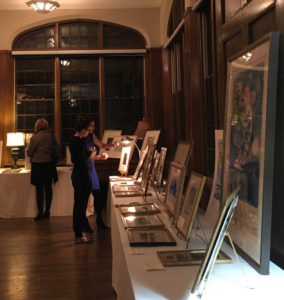One of my favorite events last year was a presentation at the University Club of St. Paul on the topic of how to begin collecting art. Here are some tips that I shared with the audience.
- Curate your collection.
If we define the term curate as, “selecting objects with a specific point of view,” then you are the head curator of your home. The specific point of view is YOU, so select things that make you happy and let your home reflect your interests. Don’t collect to please others, but do negotiate with your spouse or partner 😉
- Look, look, and look some more.
Look at as much art as you can (preferably in person!) and start to determine what draws you in and what you find yourself thinking about later. Is there a specific style, format, or subject matter that calls to you over and over again? Train your eye and devote some time to this enterprise.
- Don’t forget your tool belt.
There are many online resources as well as apps for that super computer that doubles as your phone. If nothing else, use your smart phone to create a photo album of works you like. Consult a catalogue raisonné for a list of all the works of art by a certain artist. Have a magnifying glass and a measuring tape on hand—these can be invaluable in determining originality.
- Know what you are buying.
The terms “original” and “authentic” are used with abandon on the Internet and in online descriptions. Become an educated consumer and understand the differences between an original, a re-issue, a reproduction, and a fake. Make informed decisions on which one is best for you and your budget.
- Get the best value.
Tied with originality, know about the value of what you are hoping to acquire. Know when edition numbers, signatures, stamps, and provenance add to value. And if you can resist buying art on a cruise ship or hotel auction, you will do better in the end.
- Get the best out of your source.
Whether you buy at an auction house, a gallery, through a private dealer, on eBay, Craig’s List, an estate sale, or out of the trunk of a car, ask lots of questions. A great start is, “What can you tell me about this piece?” Know that each of these sources has a different investment in the work of art and expect to see that reflected in the final price.
- Consider condition.
Unfortunately, condition never gets better and restoration and conservation can be expensive. Ask to see the back of the painting or print, open up the frame if you can, look for damage on furniture and decorative arts, and really assess if this is the right piece for you. Sometimes, a little damage can be tolerable if you want a specific work, but try to buy the best condition you can afford.
- Take care of your art.
Make sure your home is equipped to provide a safe haven for your new pieces. Use archival materials to frame, and if what you bought is light sensitive, keep it out of direct sunlight.
- Keep good records.
Keep receipts together and create a binder or file to amass any information you find on your artists or your objects. You will be surprised at how quickly it is apparent that you are actually a collector. A jump drive with photos of all your art is also a great tool that can be stored away from your home in case of emergency.
- Start to buy!
Have courage and take the plunge! You will make a mistake (or two!), but that’s all part of the process. Remember that you are the head curator and trust your taste. Of course, buy within your means, but be prepared to reach if you find something spectacular.
- Refine and evolve.
Buying a work of art is not like getting a tattoo—you can change it if you want. Bringing in a new purchase can enliven a room or space, however it may also mean that something has to go—this is ok! We are collectors not hoarders.
